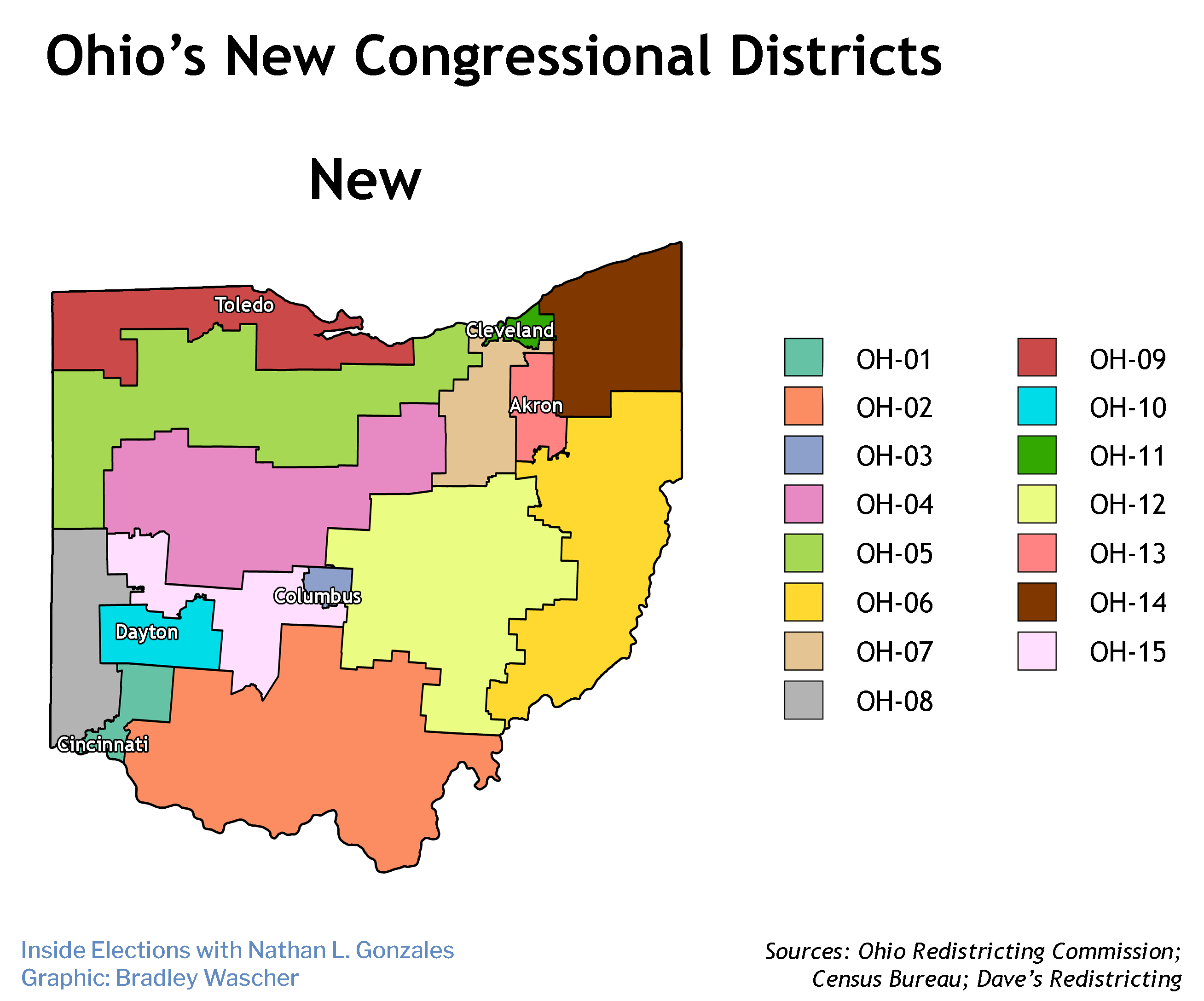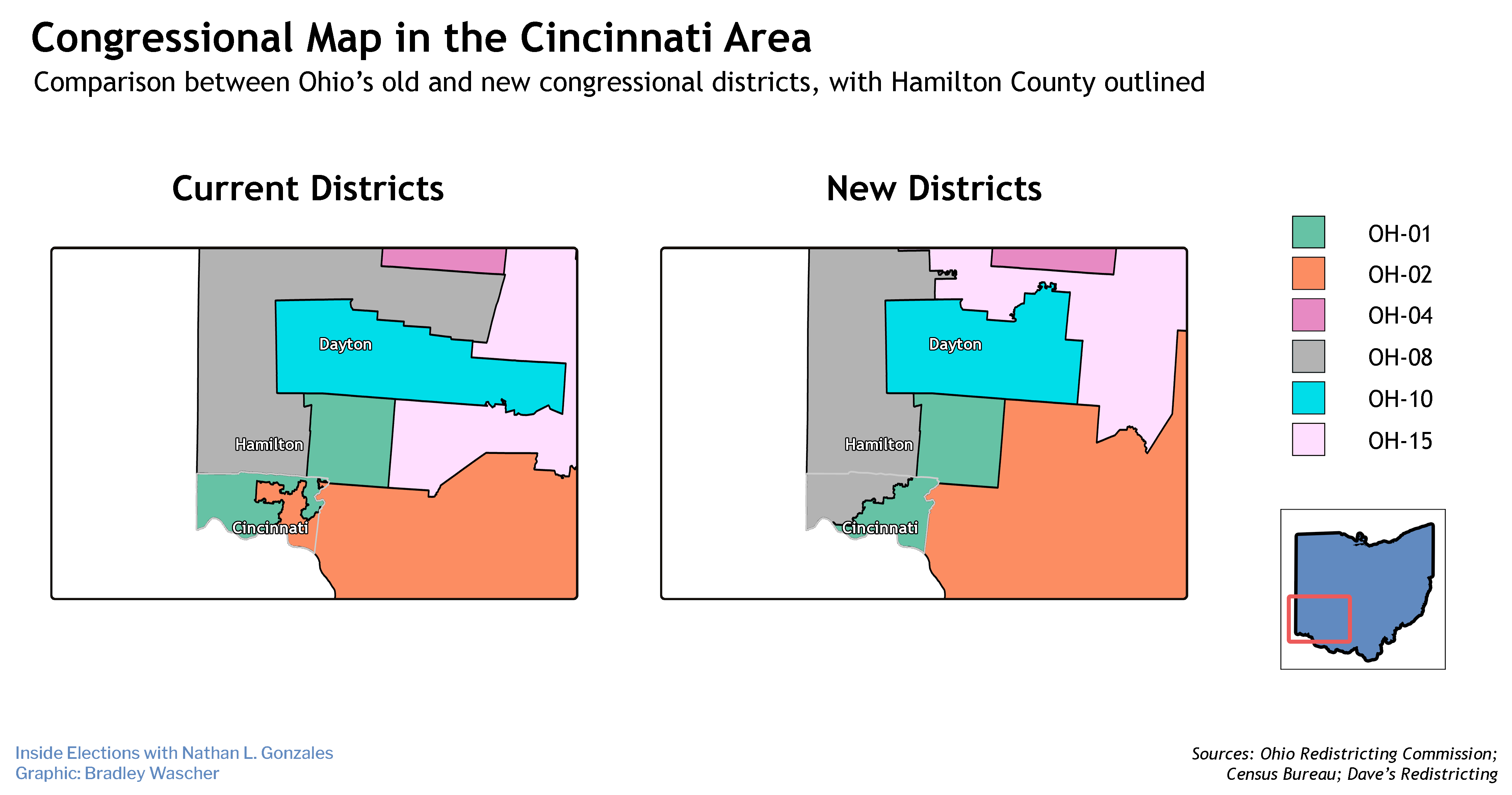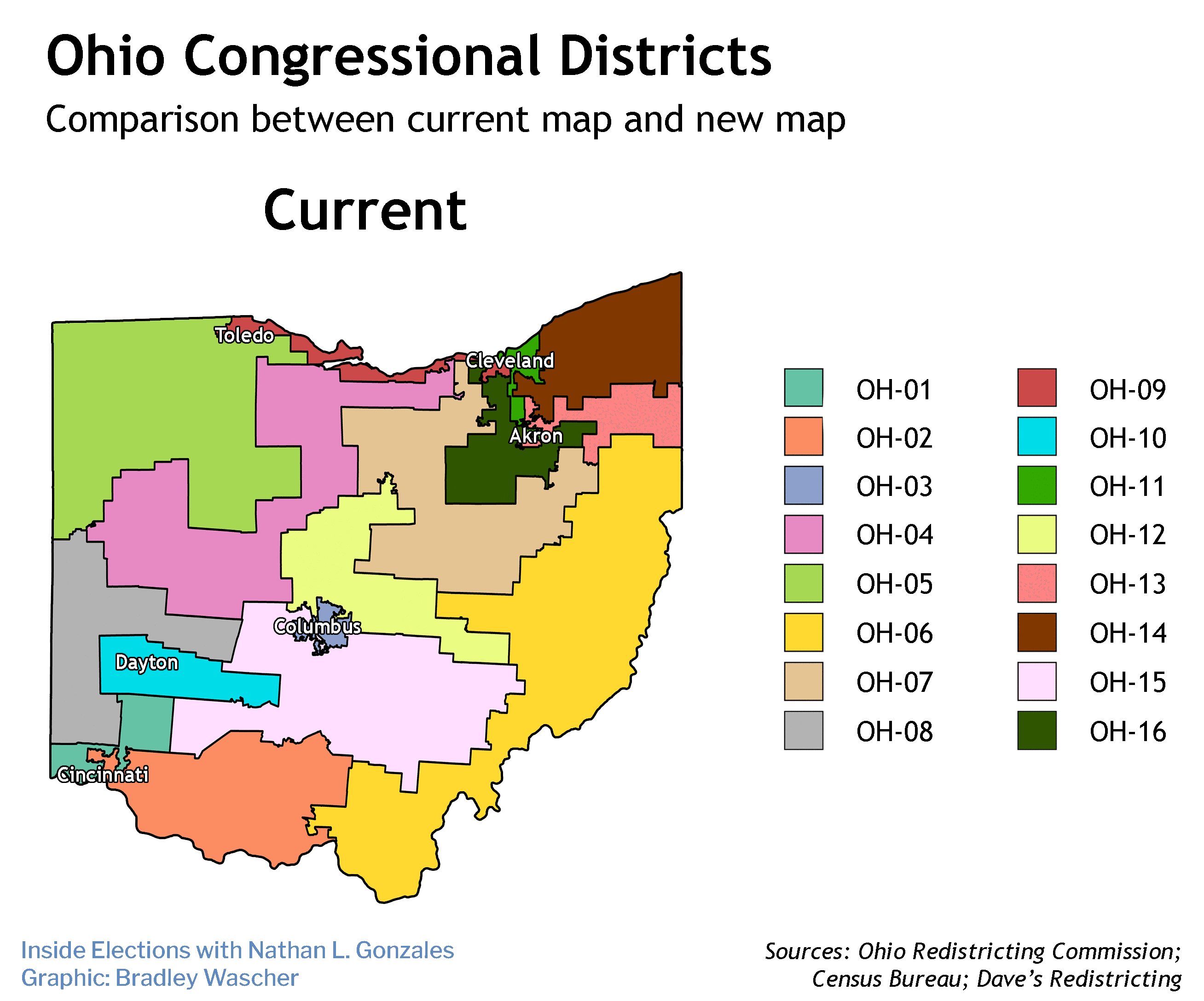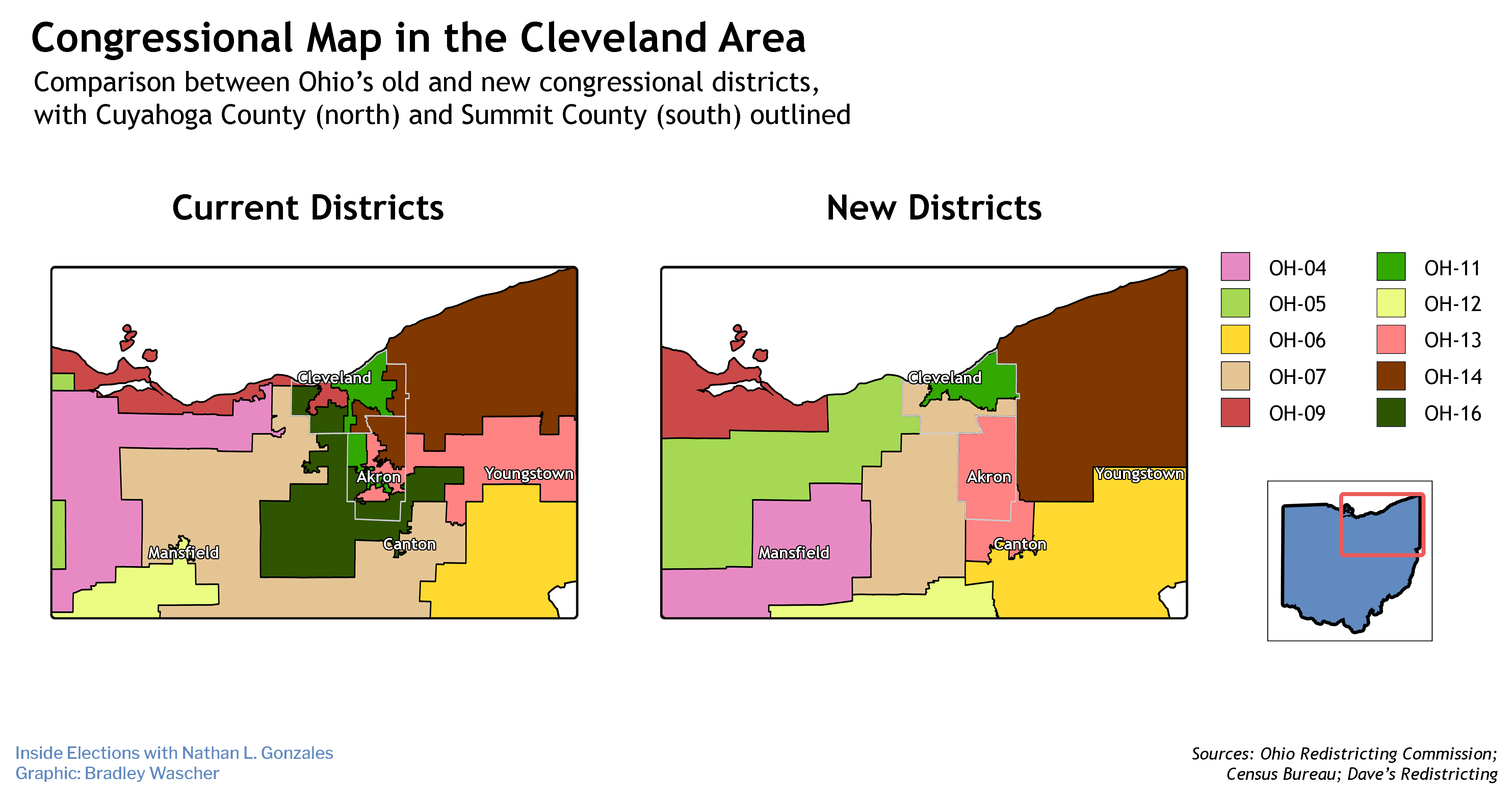Ohio Redistricting Redux: Maps, For Now
April 22, 2022 · 12:35 PM EDT
Ohio’s redistricting process for the 2022 midterms appears to have ended as it began: messily.
After a tumultuous process that saw the state legislature and a backup commission fail to (or even make a good-faith attempt to) pass bipartisan maps as required by a new state law passed by voters in 2018, the state legislature passed temporary maps on a party-line basis that would have lasted just four years instead of the usual 10.
The Ohio Supreme Court ruled those maps were an unconstitutional Republican gerrymander and tossed them out. But Republicans in the state legislature didn’t budge, and passed another map on a party line vote that was not much different than the invalidated map.
Democrats had hoped the state Supreme Court would strike down the second map as well. They still may, but the Court scheduled arguments for after the state’s May 3 primary, so in all likelihood the new map will be in place for at least the 2022 elections.
And because it was passed on a party-line vote, even if the map survives this legal challenge it will expire after 2024, and the whole process will start again.
Ohio lost a seat during the reapportionment process, dropping from 16 to 15 districts. Currently, the delegation is split between 12 Republicans and 4 Democrats. Under the map likely to be used in 2022, Republicans could win as many as 13 of the state’s 15 seats.

1st District
One bright spot for Democrats in Ohio is the redrawn 1st District. While the old version of the 1st connected Warren County with the non-Cincinnati portions of Hamilton County, the new version connects Warren with Cincinnati proper and the city’s eastern suburbs.
That means GOP Rep. Steve Chabot will have 240,000 unfamiliar residents, or roughly 30 percent of the redrawn district.
More importantly, the district’s partisanship shifted markedly away from Republicans. While President Donald Trump carried the old 1st District by 3 points, 51-48 percent, Joe Biden would have carried the new 1st by 9 points, 54-45 percent. This is one of Democrats’ two legitimate offensive opportunities in the state — if the party wants any hope of salvaging its majority, it has to win seats such as this one.
Chabot ($581,000 in the bank on March 31) won close and competitive races in 2018 and 2020, and he will face another one in 2022, this time against Cincinnati City Councilman Greg Landsman ($418,000 in the bank). Chabot will have the national environment at his back, but the partisan lean of the district is less favorable for Chabot than anytime since 2008 — the last time he lost re-election. Initial Rating: Toss-up.
2nd District
With Cincinnati moving to the 1st District, the 2nd has to expand eastward to meet its population target. It now stretches into Appalachia: down to Lawrence County at the state’s southeast point across from Huntington, W.Va., up to Meigs County on the West Virginia border, and north into Central Ohio through Pickaway and Hocking Counties, south of Lancaster. Slightly less than half of the district is new territory for GOP Rep. Brad Wenstrup, with the other pieces coming equally from the 6th and 15th Districts.
Removing Cincinnati and adding much of rural Ohio makes this a decidedly more GOP-friendly district. While the old 2nd voted for Trump, 56-43 percent, the new seat would have voted for him by a whopping 72-27 percent spread. That shift could have left Wenstrup vulnerable to a primary challenge, but none emerged and Trump recently endorsed the congressman. He should have no problem in the general election. Solid Republican.

3rd District
The new 3rd is a much more compact version of the Columbus-area seat, nestled in the northeast corner of Franklin County. Roughly 69 percent of the new district’s population comes from the old 3rd, with the balance coming from the neighboring 12th and 15th districts.
Biden would have carried the new 3rd, 71-27 percent. That means incumbent Joyce Beatty’s main concern is the Democratic primary. After turning back a well-funded challenge in 2020, Beatty was gearing up to face progressive challenger Matthew Meade in 2022, but Meade pulled out of the race in January, leaving Beatty unopposed. Solid Democratic.
4th District
The old version of the 4th District was scythe-shaped, with a handle in Elyria west of Cleveland and a hook that curved south around Hancock, Hardin, and Wyandot counties before climbing north to Allen County (including the city of Lima).
The new district is more compact, beginning in Allen, Auglaize, and northern Shelby counties and extending east and slightly north up to Ashland County. On its southern border it abuts Champaign County (Springfield) and Franklin County (Columbus).
Though less than half of the new district’s population lived in the old 4th (with much of the rest coming from the old 5th) the partisanship of the district is unchanged. Trump would have carried it, 67-31 percent.
That means GOP Rep. Jim Jordan doesn’t have much to worry about. Democratic veteran Jeffrey Sites has racked up 161,000 followers on Twitter because of how hated Jordan is among the Democratic base, but he won’t come close to winning. Solid Republican.
5th District
The 5th District is the rare seat to become less compact in the new map. The old version was nestled in the northwest corner of the state and extended south around Lima. But in order to make the neighboring 9th District more Republican, GOP mapmakers cut out much of the northwest territory — Defiance, Williams, Fulton, and Lucas counties — from the 5th, and instead extended it east all the way to Lake Erie, where it picks up Democratic-leaning Lorain from the old 9th District.
Overall, the partisanship of the 5th does not change much in the new map. Trump would have carried it, 63-36 percent. GOP Rep. Bob Latta will face either Amherst City Councilman Martin Heberling III or Craig Swartz, the chairman of the Wyandot County Democratic Party — and Latta will almost certainly win. Solid Republican.
6th District
The old 6th District, which spanned eastern Ohio from Lawrence up to just south of Youngstown, was significantly below its target population, owing to Appalachia’s continued decline.
In the new map, the district sheds its southernmost counties — Scioto, Lawrence, Jackson, Gallia, Meigs, Athens — as well as Muskingum and Guernsey counties in the west.
To get to its target population, the new district absorbs the rest of Mahoning County, including Youngstown, and eastern Stark County, just outside of Canton.
Slightly more than half of the new district is from the old 6th, while 25 percent comes from the old 13th District, and 18 percent from the old 7th District.
Trump would have won the district, 64-35 percent. For GOP Rep. Bill Johnson, that means smooth sailing. Solid Republican.
7th District
The new 7th District is significantly different from the old 7th District — just 9 percent of the new district’s population comes from the old version. Instead, the majority of the new district’s population comes from the old 16th District, which was eliminated in redistricting.
The new district begins in the non-Cleveland parts of southern Cuyahoga County and extends southward through all of Medina and Wayne counties and a bit of northern Holmes County.
Current 16th District Rep. Anthony Gonzalez declared long before redistricting that he would not seek re-election to Congress at all. After the new maps were released, current 7th District Rep. Bob Gibbs initially said he would run in the new 7th despite his old district being split evenly between six new districts.
But Gibbs unexpectedly pulled out of the race in the beginning of April, in part because he was facing a challenge in the GOP primary from Max Miller, a former White House aide who was endorsed by Trump. Miller, a member of a prominent Cleveland family, has a checkered past that includes accusations of domestic violence from Trump’s White House communications director Stephanie Grisham (Miller denies the accusations), but he faces only nominal opposition in the GOP primary now that Gibbs has dropped out.
In a district that voted for Trump, 54-45 percent, the Republican nominee will be a heavy favorite this November, especially given the favorable political environment. The only Democrat in the race, podcast producer Matthew Diemer, had just $2,200 in the bank on March 31. If this map is used in subsequent cycles, this is a district that could be competitive in a better year for Democrats, especially with someone with Miller’s baggage. In 2018, Democratic Sen. Sherrod Brown would have won it, 52-48 percent, but no other Democrat has proven they can replicate his statewide success. This year, it is Solid Republican.
8th District
In the old map, the 8th District sat along Ohio’s border with Indiana, running from Butler County north to Mercer County, with an arm that extended east through Miami and Clark counties. In the new map, the 8th loses its Mercer County portion and the eastward arm (except for a slice of Miami County). Instead, it extends further south into Hamilton County, where it picks up suburbs north and west of Cincinnati.
As a result, the new seat is slightly less Republican than its previous iteration, though still considerably friendly to the GOP. Trump would have won it by 22 points, 60-38 percent. The contest that matters is the GOP primary, where Rep. Warren Davidson is facing a challenge from former Cincinnati city councilman Phil Heimlich. Heimlich, whose father is credited with inventing the anti-choking maneuver that bears his name, is running as an anti-Trump Republican. But he had just $13,000 in the bank on March 31, compared to $572,000 for Davidson. Solid Republican.

9th District
A decade ago, GOP mapmakers forced Democratic Reps. Marcy Kaptur and Dennis Kucinich into a primary fight by linking Kaptur’s Toledo seat with Kucinich’s Cleveland seat via a thin strip of Lake Erie coastline. Kaptur won, but Republicans again have her in their sights with the new map.
The new 9th no longer extends all the way east along Lake Erie into Cuyahoga County (Cleveland), instead stopping at the edge of Erie County. And rather than ending just to the west of Toledo, the district now runs all the way to the Indiana border, including all of Lucas, Fulton, Williams, and Defiance counties.
Just 40 percent of the new district’s population previously lived in the old 9th; 51 percent previously resided in the old 5th District.
Subtracting Cleveland and adding deeply conservative northwest Ohio significantly alters the partisanship of the district. While Biden carried the old 9th, 59-40 percent, Trump would have won the new district, 51-48 percent. That means Kaptur will face the most competitive general election of her 40-year congressional career.
But the longest serving woman in House history still has a few cards up her sleeve. She’s developed her own, populist, working class appeal over her tenure — Ross Perot asked her to be his running mate in 1996 — and regularly overperforms the top of the ticket in her races. The new 9th still votes for Democrats down ballot, including in 2018 for Sen. Brown, 59-41 percent, and gubernatorial nominee Rich Cordray, 50-46 percent. And Republicans have a primary to sort out first, that could potentially produce a mid-tier nominee.
If the national environment continues to look dismal for Democrats it will be tough for Kaptur to hold on, but for now this race is a Toss-up.
10th District
The 10th District is the least altered of any in the state. Previously, the 10th was anchored by Dayton and comprised three counties — Montgomery (including the city of Dayton), Greene, and the north half of Fayette — in a line from west to east. In the new map, the 10th still includes Montgomery and Greene but instead of extending east to Fayette County, it extends north to Clark County to pick up the city of Springfield. Just under 90 percent of the new 10th District’s population lived in the old 10th.
The few changes do not materially affect the district’s partisanship. Trump would have carried the new seat, 51-47 percent.
Democrats had targeted GOP Rep. Mike Turner in 2018 and 2020 but were unable to recruit a credible candidate against him in 2022. Filmmaker Baxter Stapleton is the only Democrat in the race, and had just $233 in the bank on March 31. Solid Republican.
11th District
The already Cleveland-dominated 11th District becomes even more so. It loses its knifelike protrusion into Summit County (Akron) to the south, and makes up for the lost population by expanding into the rest of Cleveland (West Park) and Lakewood to the west, and into predominantly White Cleveland suburbs — Mayfield, Mayfield Heights, Lyndhurst, and Highland Heights — to the east.
The partisanship is unchanged: Biden would have carried the new 11th, 78-21 percent.
So the real contest will be in the Democratic primary, where Rep. Shontel Brown faces a challenge from former state Sen. Nina Turner, who Brown narrowly defeated in a special election primary in 2021, 50-45 percent.
That was a minor upset for Brown, formerly the chairwoman of the Cuyahoga County Democratic primary, who began the race unknown while Turner had a national profile and fundraising base from her time as a key figure on Vermont Sen. Bernie Sanders’ two presidential campaigns.
Turner campaigned as a proud progressive supporting the Green New Deal and Medicare for All, and outraised Brown 2-to-1, while Brown ran as a partner for Biden and with the support of outgoing Rep. Marcia Fudge, and benefitted from $3 million in outside spending. Brown was able to erase Turner’s significant polling advantage by Election Day.
Now, Brown begins as an incumbent, with more money in the bank than Turner ($890,000 to $260,000 as of March 31) and new allies such as the Congressional Progressive Caucus, which backed Turner last time around. But Turner still has national star power and will be able to raise significant funds again.
In the 2021 primary, Turner and Brown split Summit County, so removing it from the district likely won’t affect either candidate’s standing. And each has something to be happy about with the new map: for Turner, the addition of progressive Lakewood, and for Brown, wealthier suburbs such as Lyndhurst.
Whichever candidate emerges from the primary will be the prohibitive favorite in the fall. Solid Democratic.
12th District
The old, boomerang-shaped 12th District was anchored by the north Columbus suburbs, with one arm extending north to Mansfield and another east to the southern half of Muskingum County.
The new 12th still includes some suburbs north of Columbus, though none in Franklin County, as well as a collection of more rural counties to Columbus’ east to Tuscarawas and Guernsey counties and south to Athens County.
The new district would have voted for Trump, 65-34 percent. That’s significantly more Republican than the old district, which voted for Trump by just a 52-46 percent spread, and means GOP Rep. Troy Balderson can rest easier after winning two close elections in 2018 (one special, one regular) and a competitive race in 2020. Solid Republican.
13th District
The new 13th District has no clear predecessor in the maps used for the past decade. The old Youngstown-area 13th District was split evenly between three new seats, and just 28 percent of the new 13th overlaps with the old 13th.
This seat is open, as both Democratic 13th District Rep. Tim Ryan and GOP Reps. Anthony Gonzalez (24 percent of the new 13th comes from his old 16th District) and Bob Gibbs (18 percent comes from his old 7th District) are not running for re-election, and Reps. Shontel Brown and David Joyce are running elsewhere.
While the old 13th connected east Akron with Youngstown on the Pennsylvania border, the new 13th is much more compact: all of Summit County (Akron), and the northwest corner of Stark County, including the city of Canton, plus a sliver of Portage County.
Biden would have narrowly carried the new district, 51-48 percent. That makes it Democrats’ second pickup opportunity in the state, and one they likely have to win to have any chance of holding the House.
The likely Democratic nominee is state House Minority Leader Emilia Sykes, the daughter of a prominent Akron political family and viewed as a rising star in the party. On the GOP side, attorney and conservative commentator Madison Gesiotto Gilbert, who was also a Miss Ohio USA, is the frontrunner in fundraising and has an endorsement from Trump. But she faces former South Carolina Sen. Tim Scott aide Shay Hawkins, who has picked up some local endorsements.
Sykes had $241,000 in the bank on March 31, Gesiotto Gilbert had $506,000 (including $200,000 in personal money), and Hawkins had $91,000. This will be a top contest in the fall. Tilt Republican.

14th District
The 14th District remains in the upper northeast corner of the state. It comprises all of Lake, Ashtabula, Geauga, Trumbull and Portage counties save for the tiniest southwest corner of Portage.
Trump would have carried the new 14th, 57-42 percent. That’s up from his 54-45 percent spread under the old lines, leaving GOP Rep. David Joyce in a strong position. The new lines pushed the top-fundraising Democrat, trial attorney Brendan Kelley, out of the race, leaving Navy veteran and nurse Matthew Kilboy as Joyce’s remaining Democratic opponent. Solid Republican.
15th District
While the old 15th District was the western and southern Columbus suburbs plus a vast swath of rural Ohio east of Columbus, the new 15th District is the western and southern Columbus suburbs plus a less vast swath of rural Ohio west of Columbus. It includes Madison and Fayette counties, the non-Springfield parts of Clark County, and parts of Miami and Shelby counties.
By population, the new 15th is an amalgam of six different districts: 34 percent from the old 3rd, 30 percent from the old 15th, 19 percent from the old 8th, and the balance from the 4th, 10th, and 12th districts. Trump would have carried it, 53-46 percent, down from his 57-42 percent spread in the old 15th.
Mike Carey, the Republican who won a special election to the 15th District last year, is running here. He would have likely faced Democrat Danny O’Connor, who lost two close elections to Balderson in the 12th District in 2018, but O’Connor recently dropped his bid, citing the new lines. That leaves retired union leader Gary Josephson as Carey’s only opposition in the general election. Solid Republican.